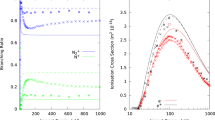Summary
Monte Carlo calculations on interactions of 300 MeV protons with carbon nuclei have been performed by means of a Remington Rand Univae U.T.C. electronic computer. In the first part of the calculations nuclear cascades of collisions on bound nucleons were studied. The same calculations were then repeated with the assumption that each cascade nucleon has a non-zero probability (30% and 40%) of colliding with an α-cluster instantaneously formed inside the nucleus. The treatment of the cascade was carried out with both the assumptions of a Fermi and of a gaussian distribution of nucleon momenta inside the nucleus. The results obtained were the percentages of cascades as functions of the number of collisions and of the number and nature of fast secondaries, the angular and energy distributions of the fast secondaries, and the excitation-energy distributions of the residual nuclei. The comparison of the results of the calculations with the few available experimental data gives the best agreement if the hypothesis of the existence of clusters inside the nucleus is adopted. The assumption that the momentum distribution of the nucleons is gaussian leads to absurd results concerning the energy spectrum of fast secondary nucleons and the spectrum of excitation energies of the residual nuclei. If, instead, one assumes a Fermi momentum distribution, the calculated spectra are reasonable and in agreement with experimental data.
Riassunto
Si sono studiate in questo lavoro le interazioni di protoni di 300 MeV di energia. su nuclei di carbonio applicando un metodo di Montecarlo a mezzo di una calcolatrice elettronica Remington Univac U.T.C. In una prima parte dei calcoli si sono studiate cascate costituite solamente da interazioni nucleone-nucleone ; successivamente si sono studiate le interazioni assumendo che ciascun nucleone della cascata avesse una probalilità diversa da zero (30% e 40%) di urtare contro una sottostruttura α, formatasi istantaneamente in seno al nucleo. La trattazione della cascata è stata svolta sia sulla. base di una distribuzione alla Fermi, che di una distribuzione gaussiana delle quantità di moto dei nucleoni in seno al nucleo. I nostri risultati si riferiscono alle percentuali delle cascate distinte in base al numero delle collisioni ed alla natura dei secondari veloci uscenti, alle distribuzioni angolari ed energetiche dei nucleoni veloci, alle energie di eccitazione dei nuclei dopo la cascata. Il confronto dei risultati dei nostri calcoli coi dati sperimentali è in accordo con l’ipotesi di esistenza di sottostrutture in seno al nucleo. L’assunzione di una distribuzione gaussiana delle quantità di moto dei nucleoni porta a risultati assurdi nelle distribuzioni delle energie di eccitazione dei nuclei e delle energie dei secondari veloci. Se invece si assume una distribuzione alla Fermi gli spettri che si ottengono sono ragionevoli ed in accordo con i dati sperimentali.
Similar content being viewed by others
References
R. Serber:Phys. Rev.,72, 1114 (1947).
M. L. Goldberger:Phys. Rev.,74, 1296 (1948).
C. F. Chew andG. C. Wick:Phys. Rev.,85, 636 (1952).
G. Bernardini, E. T. Booth andS. J. Lindenbaum:Phys. Rev.,82, 307 (1951);85, 826 (1952);88, 1017 (1952).
G. C. Morrison, A. Muirhead andW. G. Rosser:Phil. Mag.,44, 1326 (1954).
H. McManus, W. T. Sharp andH. Gellman:Phys. Rev.,93, 924 (1954).
N. Metropolis, R. Bivins, M. Storm, A. Turkevitch, J. M. Miller andG. Friedlander:Phys. Rev.,110, 185 (1958).
J. Combe:Suppl. Nuovo Cimento,3, 182 (1956);Ann. de Phys.,13, 468 (1958).
J. Combe:Journ. de Phys. et Rad.,16, 445 (1955).
E. Fiorini andS. Ratti:Nuovo Cimento,14, 961 (1959).
M. Cüer andJ. Combe:Compt. Rend.,240, 1527(1955).
M. Cüer andA. Samman:Journ. Phys. et Rad.,19, 1, 13(1958).
L. Azhgirey, I. K. Vzorov, V. P. Zrelov, M. G. Mescheryakov, B. S. Neganov andA. P. Shabudin:Soviet Phys. JETP,6, 911 (1958).
M. Q. Barton andJ. H. Smith:Phys. Rev.,110, 1143 (1958).
V. I. Ostroumov andR. A. Filov:Soviet Phys. JETP,10, 3, 459 (1960).
V. I. Ostroumov, N. A. Perfilov andR. A. Filov:Soviet Phys. JETP,12, 1 (1961).
Yu. I. Serebrennikov:Dissertation, Leningrad Polytech. Inst. (1959).
R. McKeaque:Proc. Roy. Soc., A236, 104 (1956).
D. H. Wilkinson:Phil. Mag.,4, 215 (1959).
K. K. Seth:Rev. Mod. Phys.,30, 442 (1958);Can. Journ. Phys.,37, 1199 (1959).
J. L. Fowler andJ. E. Brolley:Rev. Mod. Phys.,28, 103 (1956).
C. Møller:General property of the characteristic matrix in the theory of elementary particles, inKgl. Dan. Videnskab. Selsk. (1946).
K. A. Brueckner, E. J. Eden andN. C. Francis:Phys. Rev.,98, 1445 (1955).
E. M. Henley:Phys. Rev.,85, 204 (1952).
P. A. Wolff:Phys. Rev.,87, 434 (1952).
J. B. Cladis, W. N. Hess andB. J. Mover:Phys. Rev.,87, 425 (1952).
Simposium on Monte Carlo Method, University of Florida (1954).
A. Wildermuth andC. Kanellopoulos : Theoretical Study Division, CERN-59
P. E. Hogdson:Nucl. Phys.,8, 1 (1958).
O. Chamberlain, E. Segrè, E. Tripp, C. Wiegand andT. Ypsilantis:Phys. Rev.,96, 807 (1954);102, 1696 (1956).
W. Selove andE. J. M. Teem:Phys. Rev.,112, 1658 (1958).
R. Eisberg:Phys. Rev.,102, 1104 (1956);Bull. Am. Phys. Soc.,1, 19 (1956).
P. E. Tannenwald:Phys. Rev.,87, 205 (1952);89, 508 (1953).
J. Heidmann:Phil. Mag.,41, 444 (1950).
E. E. Gross:Bull. Am. Phys. Soc.,2, 14 (1957).
J. Hadley andH. York:Phys. Rev.,80, 345 (1950).
L. Azhgirey, I. K. Vzorov, V. P. Zrelov, M. G. Mescheryakov, B. S. Neganov andA. F. Shabudin:Soviet Phys. JETP,33, 1185 (1952).
C. Richman andH. Wilcox:Phys. Rev.,78, 496 (1950).
J. Wilcox andB. Moyer:Phys. Rev.,99, 875 (1955).
J. McEven, W. Gibson andP. Duke:Phil. Mag.,2, 231 (1957).
L. S. Azhgirey, I. K. Vzorov, V. P. Zrelov, M. G. Mescheryakov, B. S. Neganov, R. M. Rymdin andA. F. Shabudin:Nucl. Phys.,13, 238 (1959).
W. Selove:Phys. Rev.,101, 231 (1950).
Author information
Authors and Affiliations
Rights and permissions
About this article
Cite this article
Abate, E., Bellini, G., Fiorini, E. et al. Monte Carlo calculations on interactions of 300 MeV protons with carbon. Nuovo Cim 22, 1206–1236 (1961). https://doi.org/10.1007/BF02786894
Received:
Published:
Issue Date:
DOI: https://doi.org/10.1007/BF02786894




